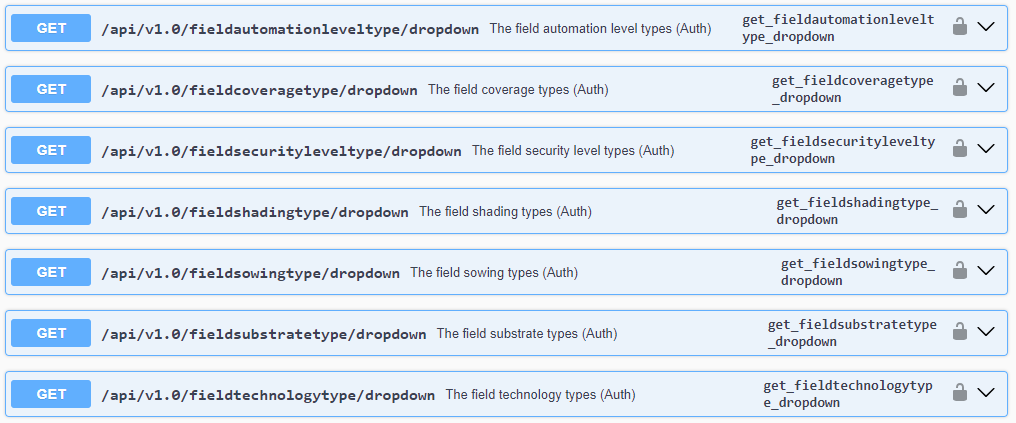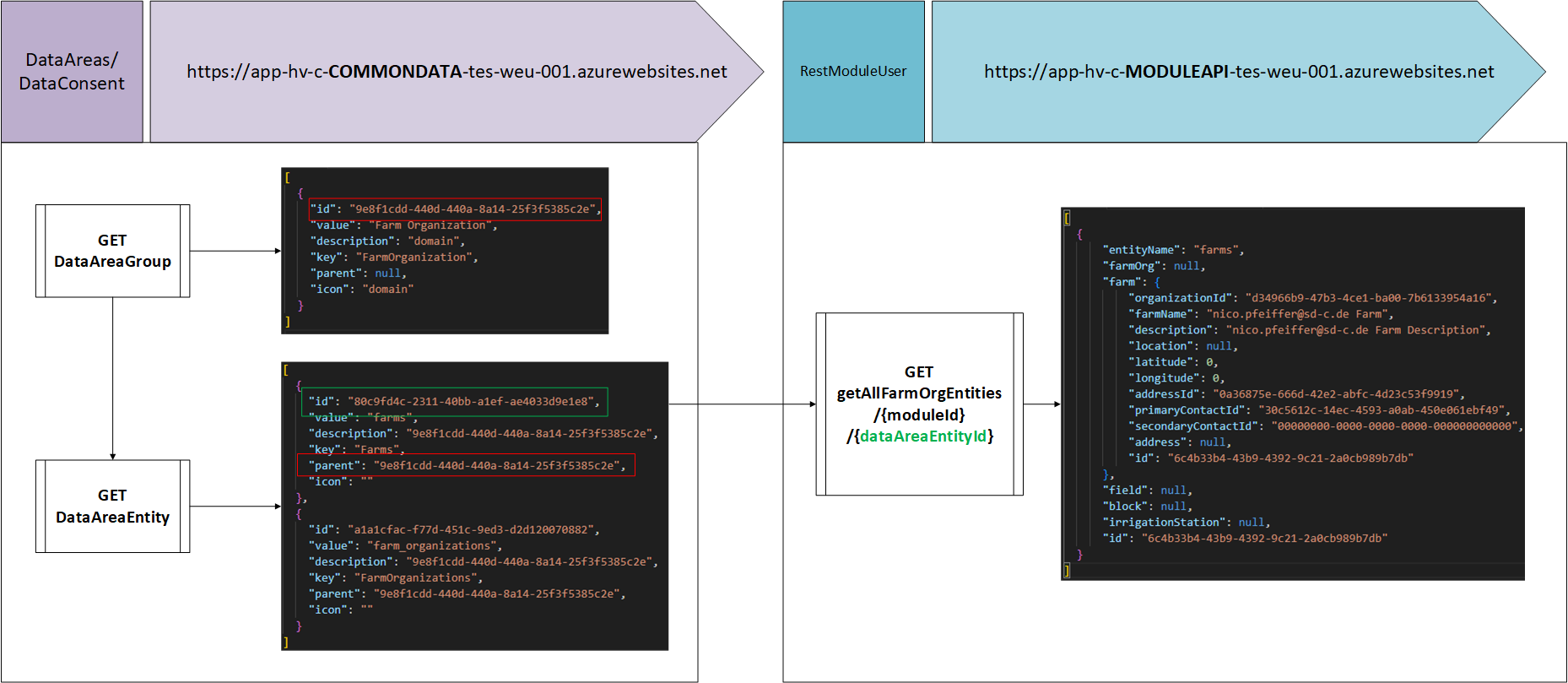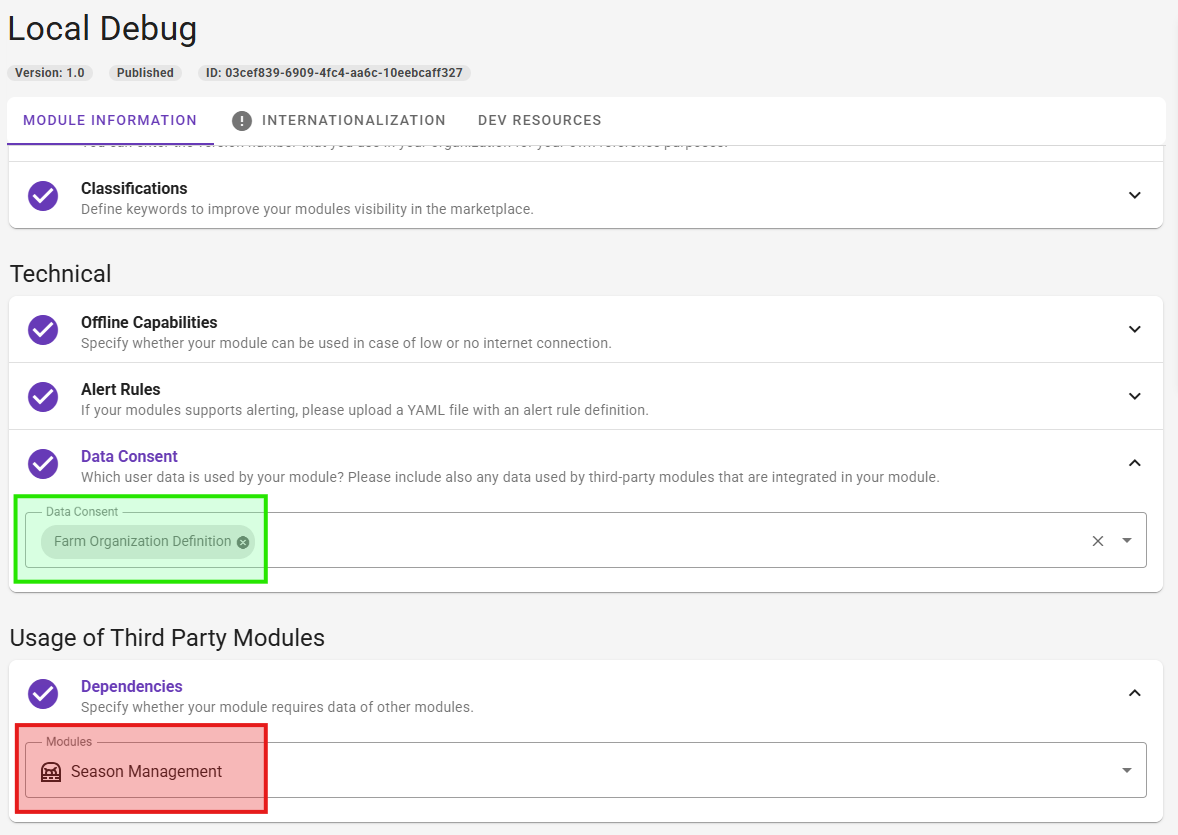API Documentation for HortiView¶
Info
Along with the API definitions, we maintain a comprehensive catalog of services and events we process in the HortiView platform. Please visit HortiView's Event Catalog for more details.
API Definitions¶
The following API definitions are available for reference. Please make sure to register with the platform in order to authenticate against the APIs.
Info
Since we are not in a public beta phase yet, we are allowing registrations and logins for whitelisted users only. If you cannot register with the platform but have a legitimate interest, please post a request to be whitelisted via hortiview@bayer.com.
Tip
You can use Swagger UI to get an overview over all available endpoints. Please be aware, that swagger gets only provided for the test environment.
CommonData API¶
Swagger
The CommonData API is used to get general platform values, such as dropdowns or static values, that don't change as often as user-dependent properties or information. These values are used across the entire application and have a longer cache time than other properties, allowing them to be cached internally more effectively.
recently changed
If you want to access any common data in the frontend, you can use the commonOptions property, which will be passed to a module as a BaseProperty.
The most common use case for the CommonData API is to access the Module API. To do this, you need the DataAreaEntity and DataAreaGroup properties:
You also have the possibility to receive dropdown data, e.g. crops or crop types:
Structure of CommonData¶
In most cases, any CommonData result will be an id-value pPair like this:
{
"id": "910c8d63-0e3b-4609-be9b-6ed2fad75b84",
"value": "Harvest & Quality",
"description": "harvest-quality",
"key": "HarvestQuality",
"parent": null,
"icon": "harvest-quality"
}
The other properties, like description and key, are internally used in HortiView. The icon value represents a Material UI-Icon, in case you want to display an icon as well.
Warning
There are some icon values that are used for custom icons, so there might be some types where no icon will be present.
Some special cases, like DataAreaGroup and DataAreaEntity, make use of the parent property. It's used to create cascading dependencies to other entities.
A DataAreaEntity contains a parent ID that points to a DataAreaGroup, so we have the possibility to connect both entities:
Season and Sensor API¶
change in progress
All module-related APIs will be replaced by moduleDepended entities, that can be accessed via the module API in the near future. Please be careful, when using those APIs in your module.
Module API¶
Swagger
Data Areas and Consent
To access user data through your module, you need to fulfill the following requirements:
- Configure the Data Areas you want to access in the Module Creation Process.
- Configure the Module Dependencies, you require access to.
- Obtain the
modulePermissionToken,orgId, and yourmoduleIdfrom the module federation. - Get farm data
- Retrieve
DataAreagroups from theCommonDataAPI.- Get the
DataAreaentity you want to access using the relatedDataAreaGroupID (CommonDataAPI). - Access the required entity via Module API using the Organization ID, Module ID, and entity ID.
- Get the
- Directly retrieve the DataArea entity with the
FarmOrgEntitiesByNameendpoint and anDataAreavalue
- Retrieve
- Get module data
Make sure to set up Data Consent and Module Dependencies, when configuring your module in HortiView:
ModulePermissionToken¶
The property modulePermissionToken is passed (along with all other base properties) to the module and saved in the BaseProps Store when the ModuleBase is initialized.
To access the modulePermissionToken, we can simply use the useBasePropsStore hook. This token can be used to access all defined DataAreaGroups (via Module API) that you specified during module configuration, as well as the CommonData API.
Get Farm Data via the Module API¶
Basic Access
This is the easiest approach to access specific data via the Module Api
First, we need to find our, what data we want to access. To do so, without too much worry, we can simply receive all DataAreaEntities, that are possible to get data from.
To do so, we can either call the following endpoint:
https://app-hv-c-commondata-{env}-weu-001.azurewebsites.net/api/v1.0/dataareaentity/dropdown
Or use the commonOptions property, to access the DataAreaEntities object. (For testing purposes, you can also take a value from Data Areas.)
Either way, the result should look similar to this one:
{
"count": 45,
"totalCount": 45,
"items": [
{
"id": "978aaeb2-91e7-4dd5-bb7e-8ba9b77b0c63",
"value": "active_subscriptions",
"description": "52b57d19-0f02-4a47-b96a-2c4cc575c52a",
"key": "ActiveSubscriptions",
"parent": "52b57d19-0f02-4a47-b96a-2c4cc575c52a",
"icon": ""
},
...,
{
"id": "80c9fd4c-2311-40bb-a1ef-ae4033d9e1e8",
"value": "farms",
"description": "9e8f1cdd-440d-440a-8a14-25f3f5385c2e",
"key": "Farms",
"parent": "9e8f1cdd-440d-440a-8a14-25f3f5385c2e",
"icon": ""
},
{
"id": "08ca7f97-53c6-4fff-a9f5-e684ffe171a9",
"value": "irrigation_stations",
"description": "9e8f1cdd-440d-440a-8a14-25f3f5385c2e",
"key": "IrrigationStations",
"parent": "9e8f1cdd-440d-440a-8a14-25f3f5385c2e",
"icon": ""
}
]
}
Now, we can use the value of the desired entity, to get some data for an organization via your module, with the Module Api:
https://app-hv-c-moduleapi-{env}-weu-001.azurewebsites.net/api/v1.0/{orgId}/FarmOrgEntitiesByName/{moduleId}?dataAreaEntityName=farms
/api/v1.0/{orgId}/FarmOrgEntitiesByName/{moduleId}?dataAreaEntityName={entity}
This call currently returns all available data of this entity, that your users module has access to in his current active organization.
For farm, that would be all farms. If you also want to get the fields, you would need to request the fields entity as well and map them accordingly.
Get Module Data via the Module API¶
To receive data from other modules, like the Season- or Device-Management, you need to call different endpoints. In contrast to platform data, you need to define dependencies within your module configuration to access its data.
To do so, we need to use to different endpoints this time:
Get your ModuleDependencies
You can access, the modules you required access to with the following endpoint:
This endpoint will return all entities, that your module has access to, due its defined module dependencies. The result will look like this:
[
{
"moduleId": "98097e68-efae-4f89-9353-abcdef123456",
"registeredEntityName": "BlockPlantLayout",
"id": "1ffc30b8-4c9d-4eac-aff2-0d12b10bb853"
},
{
"moduleId": "98097e68-efae-4f89-9353-abcdef123456",
"registeredEntityName": "Season",
"id": "89558db1-0225-4891-ba3f-974e4af1b57d"
}
]
You can use the registeredEntityName to access the related data for the entity with the next endpoint.
Get an entity from a ModuleDependency
After receiving the entities, you have access to, you can use the registeredEntityName to get the data of this entity (for your modules user)
An example response for a season looks like this:
[
{
"entityName": "season",
"season": {
"startDate": "2025-01-29T00:00:00+00:00",
"endDate": null,
"seasonStateId": "5e9e38c5-a775-4fff-b579-81e8a04c3188",
"cropSeasonName": "Test-Tomatoes-Albrice-2025-01",
"cropId": "e6fcac72-5885-45ec-8e92-fb8e1754300c",
"cropTypeId": "73f60df8-b937-4d3f-9e44-268aefcad34e",
"cropVarietyId": "132ea7de-b1e6-4c40-90ca-e05fd996f7c1",
"rootstockId": "5ac99572-8524-4972-95e7-d795c193c30f",
"farmId": "21f035a3-09bf-4ba6-a5a0-abcdef123456",
"fieldId": "6ffc7970-bcff-49ba-a442-abcdef123456",
"id": "92eaf2cb-1cc1-477c-ba90-abcdef123456"
},
"blockPlantLayout": null,
"id": "92eaf2cb-1cc1-477c-ba90-abcdef123456"
}
]
Example Implementation to Access Data via the Module API¶
React Template Example
This Example uses the React Template we provide. For an easy implementation of accessing module api data, take a look on the basic implementation
First, we need to access the DataAreaGroups and DataAreaEntities that can be accessed. The useOptions hook implements an API call for the specified entity.
DataAreaGroups for the FarmOrganization (because we want to access this group) to get the areaId. We do the same for the DataAreaEntity (for example farms) as entityId with the help of the areaId: entityId. This call also requires to pass the organizationId of the user you want to get data from and your moduleId. This function calls the Module API endpoint like this:
https://app-hv-c-moduleapi-tes-weu-001.azurewebsites.net/{OrgId}/FarmOrgEntities/{ModuleId}/{EntityId}
Data Areas¶
If your module needs to access data, it requires to have access to the data area, where the data is included. We refer to those as DataAreaGroups.
Example: If you want to access Farms, you need to have access to the DataAreaGroup called "Farm Organization Definition". The relation between DataAreaGroups and DataAreaEntity is described in Common Data
Values might change
Those values might change in the future, so its best to get possible values via the endpoint described in "Get Data via the Module API"
We have the following data areas available right now (as of 23rd of may 2025):
Farm Business Management¶
Key
FarmBusinessManagement
{
"value": "farm_data_area_consents",
"key": "FarmDataAreaConsents"
},
{
"value": "farm_organizations_subscriptions",
"key": "FarmOrganizationSubscriptions"
},
{
"value": "invoice_items",
"key": "InvoiceItems"
},
{
"value": "invoice_management",
"key": "InvoiceManagement"
},
{
"value": "invoices",
"key": "Invoices"
},
{
"value": "legal_documents_farm_acceptances",
"key": "LegalDocumentsFarmAcceptances"
},
{
"value": "subscriptions",
"key": "Subscriptions"
},
{
"value": "subscription_types",
"key": ""
}
Farm Organization Definition¶
Key
FarmOrganization
{
"value": "alert_rules",
"key": "AlertRules"
},
{
"value": "farm_organizations",
"key": "FarmOrganizations"
},
{
"value": "farms",
"key": "Farms"
},
{
"value": "fields",
"key": "Fields"
},
{
"value": "irrigation_stations",
"key": "IrrigationStations"
},
{
"value": "zones",
"key": "Zones"
}
Farm Organization Member¶
Key
FarmMember
Membership in Organization¶
Key
PersonalAssociation
Personal Information¶
Key
PersonalInformation
Device Administration¶
Key
ADMAMasterdata



